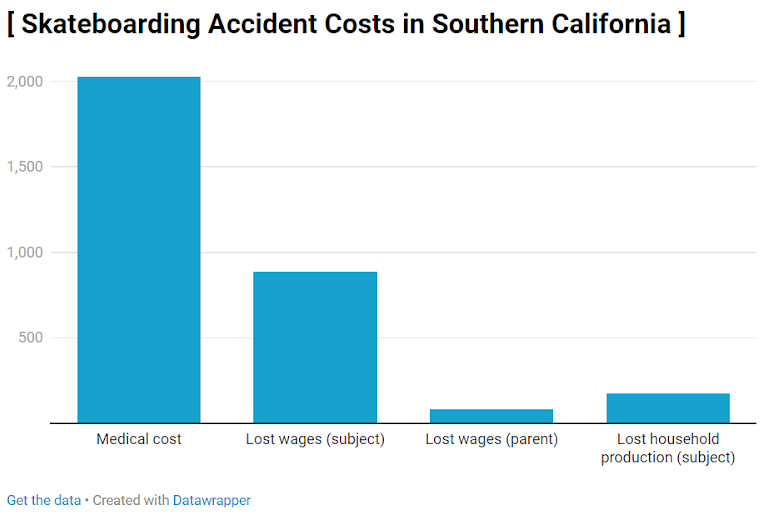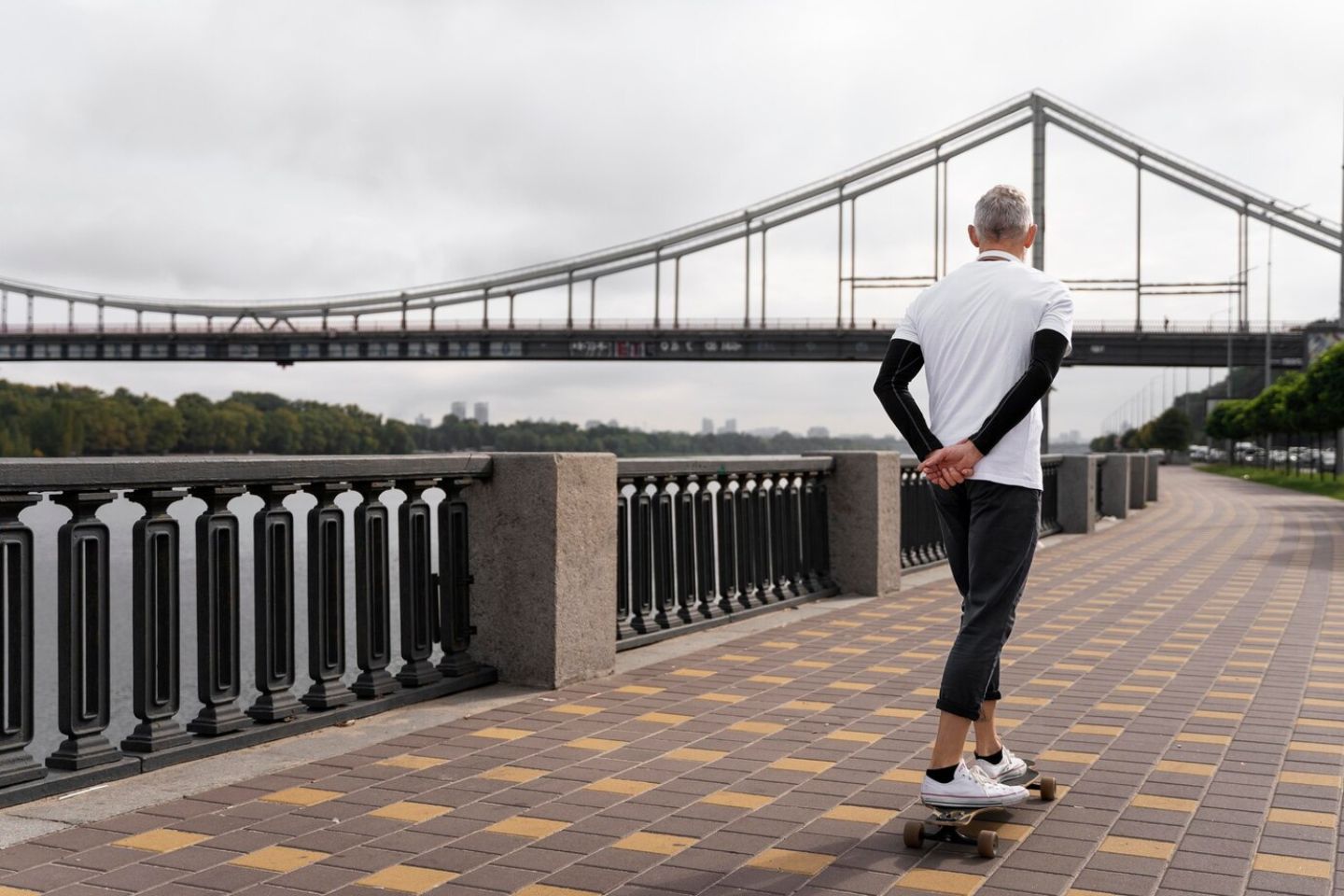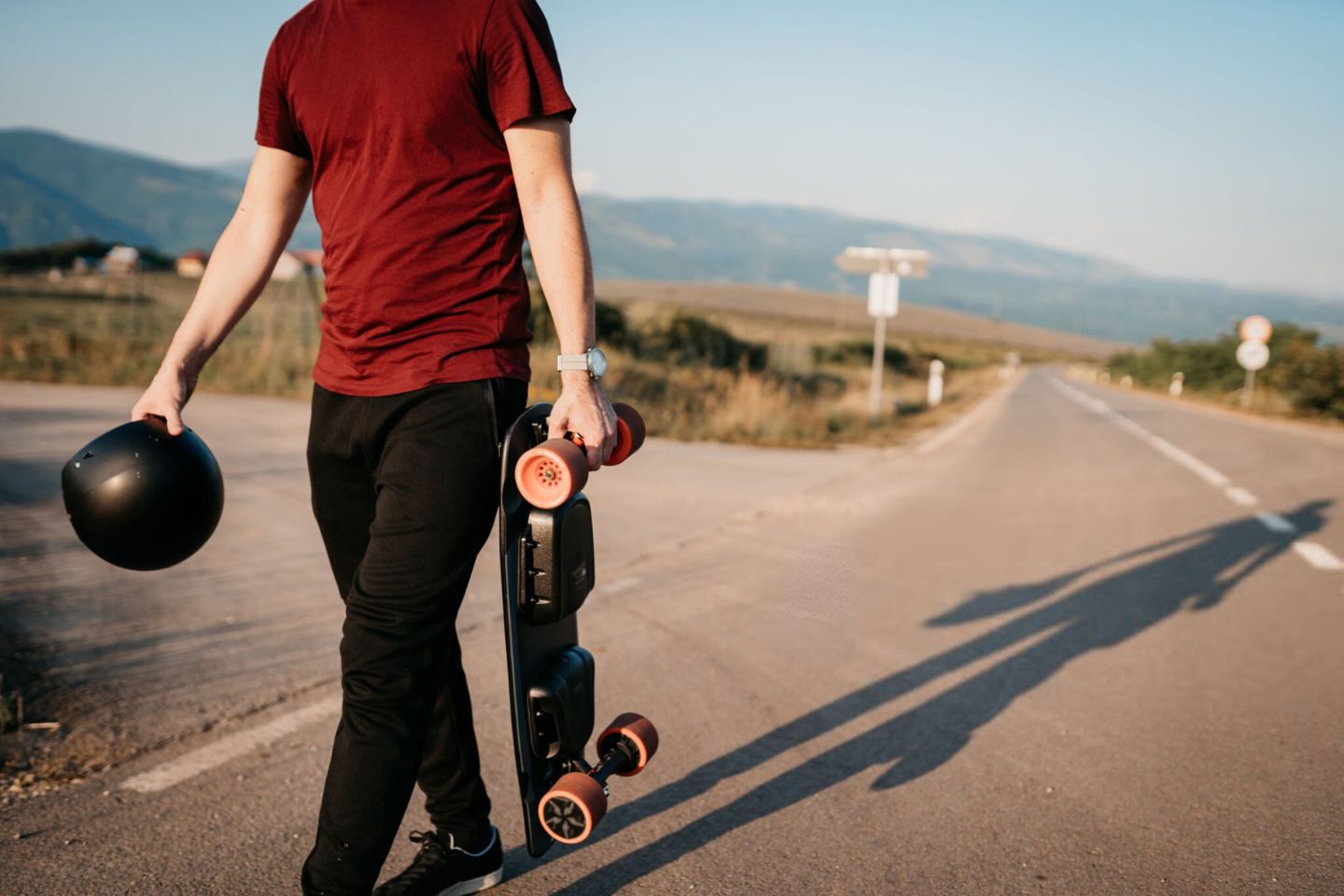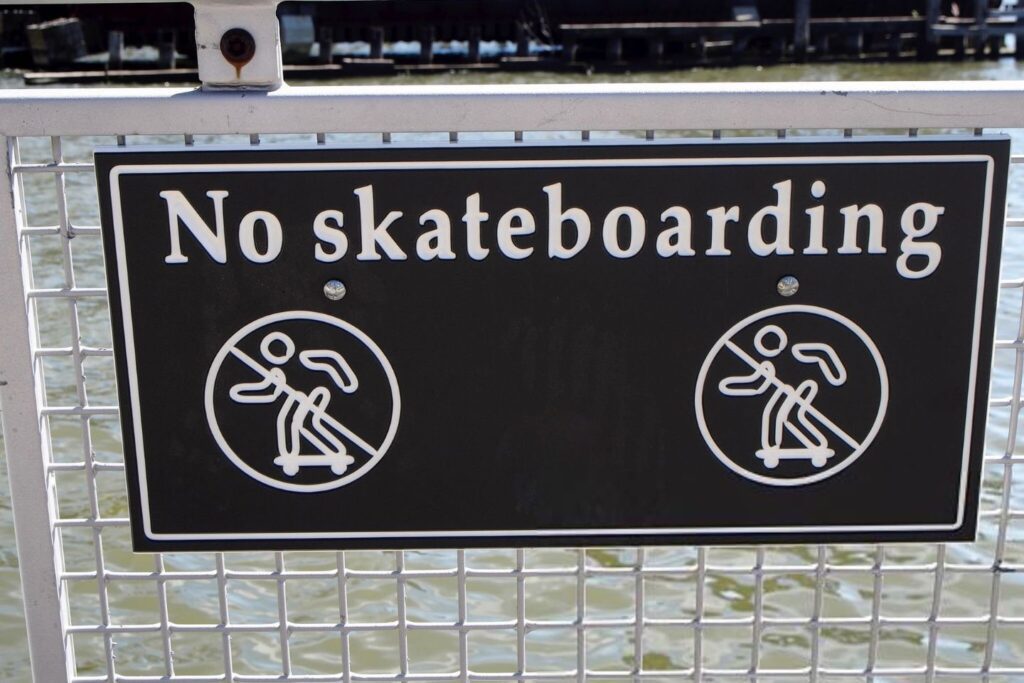As per statistics from the National Library of Medicine, skateboarding accidents in Southern California incur an average of $3,167 in total injury costs. If you’re dealing with the aftermath of a skateboard accident, understanding California skateboarding laws is essential to minimize your losses.


In this blog, we will cover everything you need to know about skateboarding laws in California. Let’s navigate the legal complexities to ensure you understand your options for seeking compensation.
Understanding California’s Skateboarding Laws


In California, skateboarding laws are governed by various regulations to ensure safety for riders and pedestrians alike. Understanding these laws is crucial for skateboarders to avoid accidents and legal repercussions.
Helmets and Safety Gear
California Vehicle Code 21212 explicitly requires individuals under 18 years of age to wear a helmet while skateboarding. This statute also includes the use of elbow and knee pads, alongside wrist guards, for individuals engaging in skateboarding within skate parks.
Designated Areas for Skateboarding in California
California Vehicle Code 21968 bans skateboarding on roads alongside certain pedestrian pathways. This law primarily aims to protect skateboarders and pedestrians by preventing accidents that can occur when skateboards are used near vehicular traffic and crowded pedestrian areas.
Designated areas where skateboarding is permitted can include:
- Skate Parks: Specially designed facilities with ramps, rails, bowls, and other features for skateboarding.
- Designated Skateboarding Zones: Some cities may mark specific areas within parks, public spaces, or even certain roadways where skateboarding is allowed under specific conditions.
- Multi-Use Paths: Areas that are designated for use by cyclists, skateboarders, and sometimes pedestrians, clearly marked to allow for safe shared use.
Property and Trespassing Laws
Under California Penal Code 602, it’s made clear that skateboarding on someone else’s property without their explicit permission is considered trespassing. This law applies to a variety of properties, including both commercial spaces like shopping centers and private homes. It’s important for skateboarders to understand that they must have permission from the property owner or be in a legally designated area for skateboarding. Trespassing while skateboarding is not permitted, emphasizing the need for respect for property boundaries.
Electric Skateboarding Laws


Electric skateboards are subject to specific laws and regulations, distinct from those governing conventional skateboards.
- Definition and Classification: Electric skateboards are classified under California law as “electrically motorized boards.” According to California Vehicle Code Section 313.5, an electrically motorized board is a wheeled device designed to transport a person, propelled by an electric motor. It has a maximum speed of 20 miles per hour on a paved surface.
- Age Limit: Riders must be at least 16 years old to operate an electric skateboard on public pathways or roads.
- Helmet Mandate: As per California Vehicle Code Section 21235, all-electric skateboard riders must wear a helmet that meets applicable safety standards.
- Speed Limit: The maximum speed limit for electric skateboards is 20 miles per hour on public roads, as mentioned in California Vehicle Code Section 22411.
- Use on Roadways: Electric skateboards can be used on roadways that have a speed limit of 35 mph or less.
- License: As per California Vehicle Code Section 21235, riders must have a license or permit while using an electric skateboard.
- Nighttime Riding: For visibility, electric skateboards used during the night must be equipped with white front-facing lights that are visible from a distance of 300 feet, side reflectors, and a red reflector on the rear. This has been specified under California Vehicle Code Section 21293.
Municipal Skateboarding Regulations in California
- San Diego: City of San Diego Municipal Code, Section 84.12 imposes restrictions on skateboarding at night, requiring the use of reflective gear or lights to ensure visibility. This regulation is aimed at minimizing accidents and enhancing the safety of skateboarders.
- Pasadena: The City of Pasadena Municipal Code, Section 3.36.400 prohibits the obstruction of traffic by skateboards. This ordinance specifically targets skateboarders who ride in a manner that disrupts the flow of vehicular and pedestrian traffic. It requires skateboarders to yield right of way and avoid actions that could lead to congestion or accidents.
- Santa Cruz: The City of Santa Cruz Municipal Code 10.68.050 specifies that you can’t park or lock your skateboard against windows, trees, planters, or in garden areas. Also, skateboarders must not place them in the way on sidewalks or streets where they might block people walking by, cars, or potentially damage property.
- Irvine: The City of Irvine Municipal Code requires skateboarders to adhere to noise ordinances when skateboarding in residential areas. This includes restrictions on the use of skateboards that create excessive noise, particularly during early morning and late evening hours.
- Monterey: The City of Monterey Municipal Code enforces a speed limit for skateboarding in public areas, not exceeding 10 mph. This speed restriction is designed to reduce the risk of collisions with pedestrians and other skateboarders.
- Oakland: The City of Oakland Municipal Code establishes ‘Skateboarding Free Zones’ in high pedestrian traffic areas, including parts of the downtown business district. Skateboarding is strictly prohibited in these zones to prevent accidents.
- Fresno: Fresno’s legal codes specifically address how skateboarding is conducted, prohibiting activities that pose a danger to public safety. This includes attaching a skateboard to a moving vehicle or skateboarding in a manner that is negligent or reckless towards pedestrians and other vehicles.
Understanding the legal landscape related to skateboarding can be complicated. If you’re struggling with injuries from a skateboarding accident, the Personal Injury Center is here to help you. We specialize in connecting you with experienced personal injury attorneys in your area, helping you navigate the legal system and fight for your rights.
Liability for Skateboarding Accidents in California
When skateboarding accidents occur, determining liability involves navigating laws and regulations. Here are some key legal codes that come into play in skateboarding accidents in California.


Negligence
California Civil Code Section 1714 holds individuals responsible for injuries caused by their lack of ordinary care or skill in managing their property or person.
To establish negligence in a skateboarding accident, one must prove the skateboarder (or the injured party) failed to act with care. For example, if a skateboarder was performing dangerous tricks in a crowded area and injured someone, they might be found negligent.
Comparative Fault
As per California Civil Code Section 1431.2, California follows a ‘comparative fault’ system. This means that if both the skateboarder and the injured party contributed to the accident, the court would allocate fault between them. This means that the court might reduce the compensation based on each party’s percentage of fault.
Premises Liability
California Civil Code Section 1714(a) specifies that property owners may be liable for skateboarding accidents occurring on their property if it can be shown that they failed to maintain a safe environment. The property owner might be held liable if they knew about the hazard and did nothing to fix it. Hazards can include an unmarked obstacle or poorly maintained pavement.
Product Liability for Skateboarding Equipment
Manufacturers and retailers can be held liable if a defect in skateboarding equipment causes an accident. If a skateboard breaks due to faulty manufacturing during normal use and leads to an injury, the manufacturer might be liable for damages under product liability laws.
California Civil Code Section 1792 implies warranties into the sale of consumer goods. It asserts that consumer goods must be free from any defect that renders them unfit for the use for which they were designed.
Government Liability in Public Spaces
Government Code Section 835 outlines the conditions under which a public entity (such as a city or county) can be held liable for injuries. Liability arises if the injury is caused by a dangerous condition on public property. If a skateboarder is injured due to poorly maintained pavement in a public skate park, the governing body responsible for the park’s upkeep could be liable.
Insurance Coverage
Often, insurance policies may provide coverage for liability arising from skateboarding accidents that occur on the policyholder’s property. Skateboarders and property owners should review their insurance policies to understand the extent of coverage for skateboarding accidents, including any exclusions or conditions that may apply.
If you have been injured due to a skateboarding accident, remember that you are not alone. The Personal Injury Center is here to simplify the process. We’ll connect you with skilled personal injury attorneys in your area who are well-versed in California skateboarding laws to maximize your claim.
Types of Compensation in Skateboarding Accidents


Victims of skateboarding accidents in California may be entitled to various types of compensation, depending on the circumstances surrounding their accident. Here’s an overview of the primary forms of compensation available.
Medical Expenses
California Civil Code Section 3333 allows for the recovery of medical expenses as part of compensatory damages in personal injury cases. This includes costs associated with medical treatment, including hospital stays, surgeries, medications, physical therapy, and future medical care related to the accident.
Lost Wages and Earning Capacity
Compensation for lost wages involves payment for the actual income lost during the recovery period due to the inability to work. It is typically quantified based on documented past earnings and anticipated work hours.
On the other hand, lost earning capacity refers to the projected reduction in future income resulting from sustained injuries. It includes factors such as diminished employability, limitations on career progression, and potential vocational adjustments necessitated by the injuries.
Both aspects are integral to ensuring equitable financial redress for the economic ramifications endured by the injured party.
Pain and Suffering
Non-economic damages can be claimed by the victim. This includes claims for physical pain, emotional distress, suffering, inconvenience, and the loss of enjoyment of life resulting from the California Civil Code Section 3333.2 places no cap on pain and suffering damages in personal injury cases, except in medical malpractice cases.
Punitive Damages
Punitive damages are aimed at compensating the victim, as well as punishing the defendant for particularly harmful behavior and deterring such conduct in the future. This type of compensation is considered when the defendant’s actions show a reckless disregard for the safety and well-being of others.
Under California Civil Code Section 3294, punitive damages can be awarded if it is proven that the defendant acted with malice, oppression, or fraud. “Malice” refers to conduct that is intended to cause injury or that is carried out with a dangerous disregard for the safety of others. “Oppression” involves harsh, cruel, or unjust treatment of individuals. “Fraud” is defined as deceptive behavior that results in financial or personal gain for the perpetrator at the expense of the victim.
Wrongful Death and Survivor Actions
In cases where a skateboarding accident leads to death, the victim’s family may seek compensation for funeral expenses, lost future income, loss of companionship, and other damages. California Code of Civil Procedure Sections 377.60-377.62 allows certain family members to file a wrongful death claim.
Loss of Consortium
Under California Civil Code Section 1431.2, loss of consortium damages compensates the spouse or domestic partner of the injured party. The compensation is for the loss of companionship, affection, and sexual relations due to the injuries sustained in the accident. This type of compensation acknowledges the impact of the injuries on the victim’s significant relationships.
Property Damage
This includes compensation for the repair or replacement of personal property damaged in the accident, such as the skateboard itself or other personal belongings. It may also cover items like a damaged cell phone, torn clothing, or a broken watch that was on the victim at the time of the accident.
The aim is to financially restore the victim to the state they were in before the accident occurred. Valuation of damaged property will be based on current market prices, and receipts or estimates may be required to substantiate claims. This ensures a fair and objective assessment of losses.
Rehabilitation Costs
Rehabilitation costs cover expenses for physical and occupational therapy, counseling services, and any other rehabilitation needs that arise as a result of the skateboarding accident. These costs can also include specialized equipment needed for rehabilitation, such as braces or wheelchairs, and the services of professionals like physiotherapists or speech therapists.
This is aimed at restoring the victim to the pre-accident condition. Rehabilitation may be a long-term process, and these costs account for both current and anticipated needs, ensuring the victim receives comprehensive care for a full recovery.
Home and Vehicle Modifications
Victims who suffer severe injuries requiring changes to their living or transportation arrangements may seek compensation to cover the costs of modifying homes and vehicles. Modifications can include installing wheelchair ramps, stairlifts, or widening doorways in homes, and adapting vehicles for hand controls.
These adjustments aim to improve the victim’s mobility and independence, reducing the impact of their injuries on daily life. The cost can vary greatly depending on the extent of modifications required, and compensation seeks to ease this financial burden.
Navigating the aftermath of a skateboard accident can be overwhelming. Let the Personal Injury Center guide you through this challenging period. Our team will link you with experienced personal injury lawyers specializing in skateboard accidents to ensure you receive the compensation you’re entitled to.
Key Takeaways
|
FAQs
Is it illegal to skateboard on the sidewalk in California?
The legality of skateboarding on sidewalks in California depends on local city or county laws. Some areas allow it, while others restrict or prohibit skateboarding on sidewalks for safety reasons.
What is California’s skateboard helmet law?
In California, anyone under the age of 18 is required to wear a helmet while skateboarding. This law is enforced to reduce the risk of head injuries among young skateboarders.
Are skateboarders considered pedestrians in California?
Skateboarders are not considered pedestrians under California law. They are subject to their own set of regulations, separate from those that apply to pedestrians, to ensure both their safety and that of others around them.
Is skateboarding against the law in public spaces?
In California, skateboarding in public spaces is regulated by local ordinances, with some areas permitting it and others imposing restrictions. Check your local city or county laws to understand where skateboarding is allowed.



